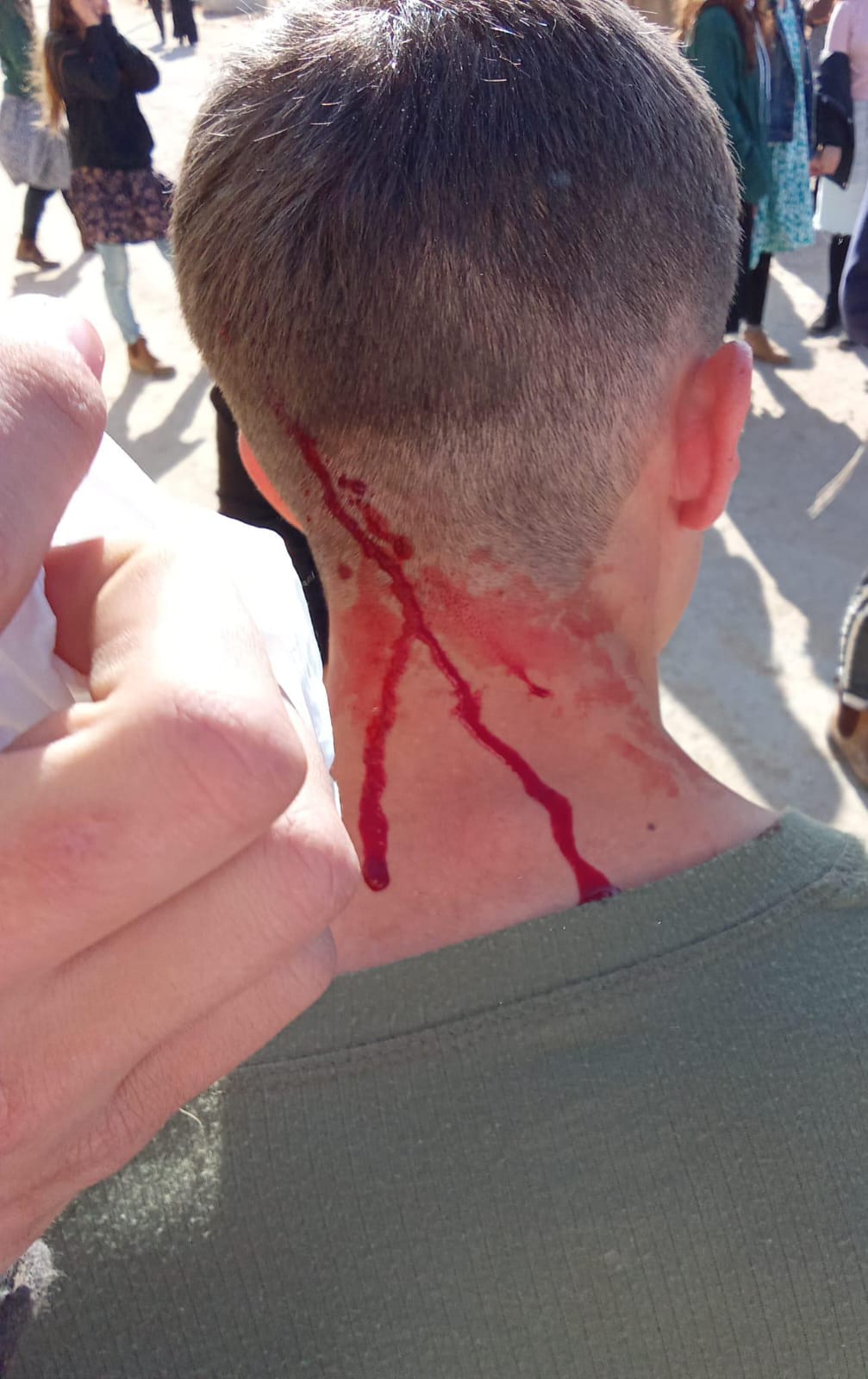
Injured protester; Photo credit: Zimrat Ben Tzuriya
Wednesday, March 6, 2024, 9:37 Approximately two weeks ago, dozen of youths took part in a demonstration at the Kerem Shalom Crossing protesting the passage of humanitarian aid trucks to the Gaza Strip. At some point, the soldiers started to forcibly and brutally remove the youths. One of the soldiers hurled a rock at the head of one of the youths, a minor, injuring him. Following the incident, Honenu Attorney Ophir Steiner wrote a letter to the Military Advocate General demanding an investigation into the brutal treatment of the youths.
In his letter, Attorney Steiner described how the protest took place without incident until the arrival of a senior commander who ordered the forced removal of the youths: “On February 22, 2024, in the morning, several dozen protesters, most of them minors, who had slept overnight near the Kerem Shalom Crossing, arrived at the site to protest the passage of trucks laden with goods from Israel to the Gaza Strip. Initially, the protesters moved freely at the site, carrying signs and calling out protest slogans. Later, some of the protesters noticed the trucks standing nearby. They noticed that IDF forces were preparing an alternative traffic lane a short distance from the main road that bypassed the area of the protest. Simultaneously, cranes arrived near the area of the protest and placed four-meter tall concrete wall panels to form a barrier between the main road and the alternative traffic lane.
“The protesters approached the concrete wall panels and tried to pass between them to the alternative road. IDF forces were positioned close to the panels. They noticed a few youths passing through a narrow opening between concrete panels to the area where the alternative road was. The soldiers approached some of the protesters and asked them not to pass the wall. In any event, approximately 20 protesters, the vast majority of them minors aged 14-17, passed through the narrow opening and sat near the concrete wall, on the ground and on the roofs of empty concrete guard posts. The soldiers did not attempt to remove them in any way.
“Approximately half an hour later, the soldiers began to gather in front of their commanders. The senior commander, a brigadier-general, was also at the scene. Immediately after the talk with their commanders, most of the soldiers put on masks. Then, a loud call was heard: ‘Fall in!’ At the sound of the call, the soldiers rushed toward the protesters. Some of them shoved the protesters standing near the wall so that they would advance toward the narrow opening. Others quickly climbed onto the guard posts and pushed the protesters, knocking them onto the ground. The protesters were all forced toward the narrow opening that allowed only one person at a time to pass. The soldiers pushed them with the aim to force them through the narrow opening. They shoved them and crowded them to the point of suffocation. They punched them, kicked them with their army boots, and beat them with their rifle butts. At this point, one of the soldiers hurled a large rock at the head of one of the protesters,” described Attorney Steiner.
Attorney Steiner cited in his letter that the soldiers forced the youths to crowd together to the point of danger of suffocation: “Pleas of the protesters, who were minors, were to no avail. The masked soldiers shoved them until the last of them passed through the narrow opening. Women soldiers who were called to the site to assist with handling the girls protesting, pushed minors, students at religious institutions, who shouted that they refrained from touching boys [shomrot negia] and pleaded not to be shoved into the boys. The girls were forced to squeeze their bodies next to the boys’ bodies. It is difficult to explain to an observer [unfamiliar with religious customs] how uncomfortable this experience was for the girls.”
Further on in his letter, Attorney Steiner brought several personal testimonies from the youths, girls and boys, that describe the brutality: punches, kicks, beatings with rifle butts, and excessive force. One of the testimonies is from L., a minor who was shoved with the rest of the youths until one of the soldiers rushed over to him, holding a large rock, and slammed it into his head. The youth was injured and blood sprayed from his head (see photo at right). Some of the other testimonies describe how the blood sprayed on them. Some of the girls’ testimonies described how they tried to record the most brutal part of the incident, but soldiers threw their cell phones to the ground, breaking them. Attorney Steiner attached video clips and a photograph of the soldier who, according to testimonies from the youths, slammed the rock into the youth’s head, to his letter. Additional documentation of the injury was also attached.
Honenu Attorney Ophir Steiner commented on the incident: “Extreme force was exercised on the minors. Dozens of youths were packed into a narrow corner. Then, as if in a ‘human press,’ the soldiers applied immense physical pressure on them. The soldiers punched and kicked them and beat them with their rifle butts. They could have sustained much more serious injuries. The force applied to the youths deviated from every standard of ‘reasonable force’. Slamming a rock directly into one of the minors’ heads is definitely a criminal act that indicates malicious intent. The Military Advocate General must investigate the incident and bring the brutal soldiers to justice.”
